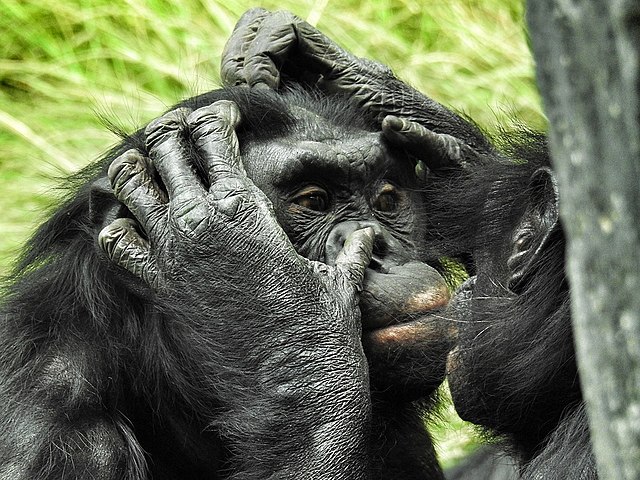
This guest article by 13-year-old Ira Parsons, a member of Congregation Or Adam in Phoenix, AZ offers a thoughtful reminder of lessons we can learn from some lesser known mammals. Ira celebrates his B Mitzvah this coming weekend. There are various times during the year where we can even learn about our humanity from observing other species. Earth Day celebrated on April 22 offers an opportunity to so.
The surprising answer is: “More than you might think.” As we observed Tu B’Shevat, which some equate with a “Jewish version of Earth Day”, our attention turned to the environment, its fragility, our own role in its destruction, and our responsibility to help repair a broken world.
As humanists, we are interested in the Natural World and our place in it, including who we are, and from where we came. Bonobos, recently recognized as a completely-separate species from chimpanzees, are our closest living relatives. No animal shares more genetic code with us.
Sadly, bonobos (once known as “pygmy chimps”, but very different from chimps in behavior) are one of the Earth’s rapidly-declining species, far along the road to extinction. Only now, as we risk losing them, are we beginning to understand the critical lessons they can teach us:
- Unlike their patriarchal and violent chimp cousins, bonobos are matriarchal and peaceful, comprising societies in which violence against each other is unknown.
- Bonobos learn by constantly playing, but their play is far from frivolous. It appears to be a critical means to solve problems and avoid conflict.
- Many primatologists now reject the unproven assumption that apes — including humans — are natural-born killers.
- Bonobos help explain the evolution of kindness, empathy, and reciprocity, which Hillel described as “the whole of the Torah” (the rest being “mere commentary”), which Christianity later called “The Golden Rule”, and which so many universal philosophies extol today.
Human kindness appears to be a biological trait, deeply rooted in our primate legacy, long predating religion, and not something that needs to be imposed by authority. We and the bonobos all share this innate instinct for compassion, bonding, and trust. The Law of the Jungle isn’t so savage after all.
February 14 marks World Bonobo Day, when people around the globe — from evolutionary biologists and behavioral scientists to environmentalists, animal lovers, and ordinary citizens — focus on the existential peril to this species in which we glimpse so much of ourselves.
What Are Bonobos? 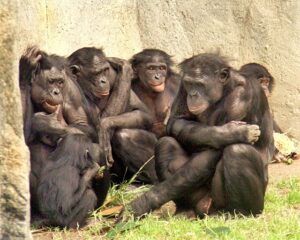
31 million years ago (MYA) our ancestors split from monkeys; 20 MYA from gibbons; 16 MYA from orangutans; 9 MYA from gorillas; 6 MYA from the common ancestor of chimps and bonobos; and less than 1 MYA, chimps split from bonobos, which together comprise the genus “Pan” (Pan troglodytes and Pan paniscus, respectively). Science recognized bonobos as a separate species in 1933.
The word “bonobo” first seen in 1954, is a misspelling of “Bolobo,” a town on the Congo River in the Democratic Republic of Congo, the only place they live in the wild, south of the river.
There is less than one-half of one-percent of difference between chimp and bonobo DNA. Chimps are larger, with shorter legs, and less likely to walk or stand on them. Their faces, ears, hands, and feet are pink; bonobos’ are black.
Chimps rely on cunning and competition; bonobos emphasize cooperation and sharing. Chimps are patriarchal; bonobos are matriarchal. If a bonobo male is aggressive, the females chase him into the forest. Chimps kill rival (and baby) chimps, with a murder rate comparable to modern humans, yet bonobo-on-bonobo violence is unknown in the wild.
When one chimp tribe encounters another, it murders the males and babies, and rapes the females, whereas bonobos eye each other wearily, make vocalizations, then rush to embrace and play. Chimps “slug it out”; bonobos “hug it out”.
A change in habitat had profound implications for their evolution. Both live along the River Congo, chimps on the north, bonobos on the south. Their environments are similar today, but 2.5 MYA, drought wiped out gorilla food sources on the south, and the gorillas fled. When the drought ended, the forest returned, but not the gorillas.
Chimp/bonobo ancestors had the forest to themselves on the south, allowing travel in large, stable parties, and strong social bonds; these became bonobos. Those on the north continued competition with gorillas, mothers had to roam alone with infants for food, and lacked time for social bonding; these became chimps.
A 2018 study found structural differences between chimp and bonobo brains. Circuits that control social/emotional behaviour predisposes bonobos to sharing, tolerance, negotiation, and cooperation. These same traits allowed Homo sapiens to share ideas, and outlast other early humans.
What Can Bonobos Teach Us About Ourselves?
In 1947, Winston Churchill famously said, “The story of the human race is War. Except for brief and precarious interludes, there has never been peace in the world; and before history began, murderous strife was universal and unending,” but Churchill was no primatologist. He was a politician reflecting popular bias — and he was wrong.
Science has traditionally shared this chimp-like view of our ancestors. As late as 2009, an evolutionary anthropologist at Kent State famously concluded humans could not have descended from a common ancestor with apes, citing the early human Ardipithecus ramidus, who lived in Ethiopia 4.5 MYA, and had small, blunt teeth, not long, sharp canines like male chimps. These small canines perfectly match the bonobos’, as do its long legs, narrow shoulders, and grasping feet — yet he rejected bonobos as the archetype for a common ancestor of apes and humans, never considering the chimp might be merely a violent outlier.
Modern hunter-gatherer groups co-exist peacefully most of the time. Organized violence emerged only after humans settled, and began acquiring land and livestock. Archaeological evidence of murder goes back hundreds of millennia, but war is a recent phenomenon, for which no fossil evidence exists before the Agricultural Revolution roughly 12,000 years ago. We have an older, stronger nature for cooperation, bonding, and trust than we do for aggression, competition, and domination.
A plausible scenario is that humans descended from peaceful bonobo-like ancestors, socializing, sharing, and playing. Bonobo play shows the evolutionary roots of human laughter, dance, and ritual. The reward system in both our brains is overdeveloped, and we share the capacity for joy. 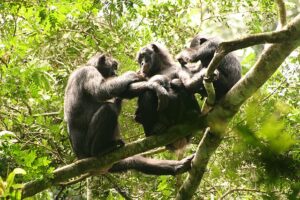
Bonobos play for hours — chasing, laughing, tickling — not just the young, but also adults. Adult play is unusual in most species. Almost all young mammals play, but usually stop at maturity. Play, especially in adults, serves a purpose related to intelligence, creativity, and trust. It’s a social glue that connects us, creating a sense of joy that spreads through any group, generating positive emotion.
We see bonobo-like play in everyday human behavior: in sports, with uniforms rules and choreography; in rituals and ceremonies, civic, religious, or academic; in public performances like drama, dance, poetry, and music; and in dress-up on Purim or Halloween.
Play suspends reality. Things that don’t usually happen become possible in play. It trains our mind to explore new and different worlds safely. It builds relationships, fosters tolerance, and teaches trust. People connect through play: making fun of themselves; engaging with strangers; and overcoming fear, risk, and anxiety. We normally avoid those, but not when we play. Think of roller coasters, haunted houses, scary films, school dances, dating, or performing in front of an audience.
Bonobos teach us that play is critical for evolutionary survival. Its tangible benefits are increased creativity, resilience, diversity, social interaction, and connections. Play allows adaptation for surviving an increasingly-complex world. It gives an evolutionary advantage in a future that will require greater creativity and cooperation.
Our Human Future
There is a biological basis for kindness, empathy, and reciprocity. Chimps can’t teach us anything about peaceful relations; they have only hostility between communities. Bonobos teach us about the possibility of peaceful relationships. They assume every stranger is a potential friend. Pop Culture might say, “Chimps are from Mars; Bonobos are from Venus.”
Some humans have lots in common with chimps: they like hierarchies, keeping people in their place, dominance and submission. Others have more in common with bonobos: they’re giving and generous, they feel compelled to help the underdog. Human societies are conflicted between chimp and bonobo traits.
We share almost 99% of our DNA with bonobos. An alternative to Churchill’s hypothesis is just as possible — maybe more so. An evolving consensus on this extends even to capitalism: a major business school recently described evolutionary differences between chimps and bonobos — identifying greed as a liability and generosity a strength — in the publication “What Can a Bonobo Teach a Hedge Fund Manager?”
In 100 BCE, Hillel voiced the basis of modern ethical and legal codes worldwide: “What is hateful to you, do not do to others.” If we understand bonobos, then we understand that kindness, empathy, and reciprocity come from the bottom up, not from the top down, as some religions contend. In a very real sense, DNA was speaking through Hillel. In the end, Humanism is an evolutionary product — and when Nature speaks, we need to listen.
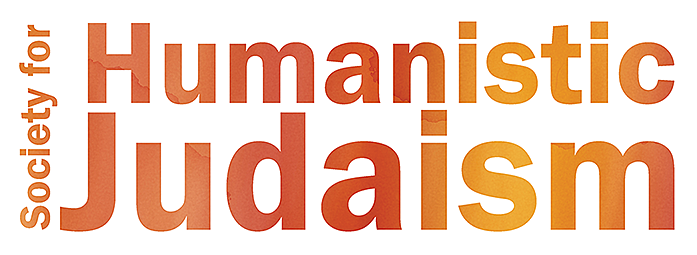

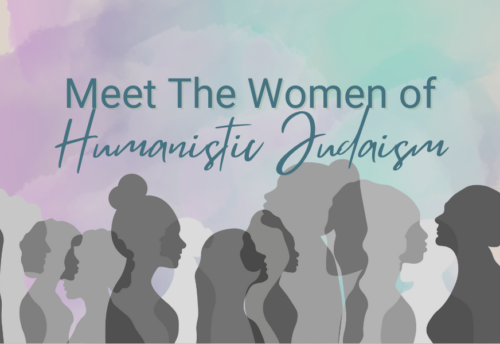
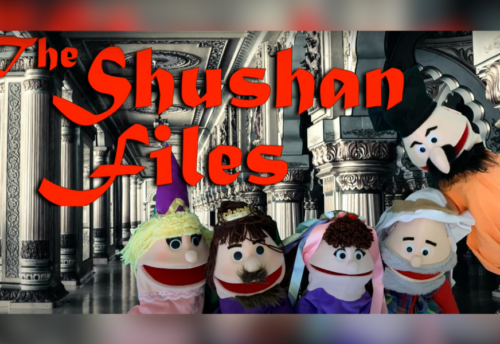
what a lovely and informative essay. thanks!
I enjoyed this essay. Thank you for sharing it.
Excellent essay about wonderful animals!
You should read Dr. Suzy’s book The Bonobo Way
https://www.amazon.com/Bonobo-Way-Evolution-Through-Pleasure/dp/0692323767